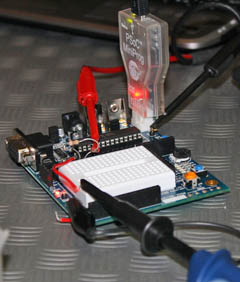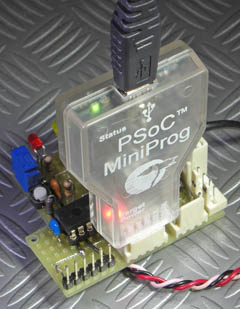Sound tone detection with a PSoC
Do you remember the op-amp based circuit? In an explorer robotic challenge the robot must autonomously find some sound sources that emit a 4KHz tone. To achieve this goal the robot has three microphones on three sides. The conditioning and revealing circuit is based on a quad op-amp and a tone detector. There is a first stage that mixes and amplifies the signals coming from the microphones, an active tunable band pass filter, a second amplifier stage and a NE567 tone detector. The remaining op-amp in the chip is used as an active virtual ground reference for all of the amplifiers, allowing higher impedance for their inputs.
My first goal was to, at least, obtain the same functions with a single PSoC. I’ve reached and exceeded that minimum goal, adding some more functionalities that will be described one by one along the text.
First of all: which kind of PSoC? Let’s start with the simplest and cheaper version, PSoC 1. This allows an easy way to start understanding this device family without spending a fortune. The PSoC 1 series was the first one realized by Cypress and it’s evolved noticeably both in analog modules features and in digital blocks availability. There are many devices in this series, distinct for maximum clock frequency, RAM and flash memory quantity and for number of blocks. The latest one is the CY8C29X66 family, sold in different version, from 24 to 64 pins; the only one available in PDIP version, good for development boards.
In both kits shown there is a CY8C29466-24PXI PDIP PSoC device sample, perfect for our purpose.
or just the cheaper miniprogrammer to use with your own prototyping or final board.

